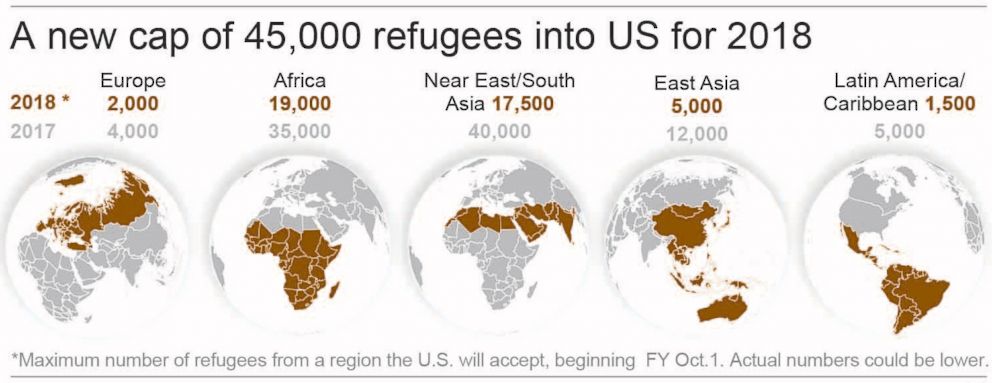Trump administration planning to cap refugees at 45,000 for next fiscal year
It's a drop from Trump's 50,000 cap last year.
— -- The Trump administration has confirmed that the U.S. plans to set a limit of 45,000 refugees for the next fiscal year -– a drop from Trump’s 50,000 cap last year and the 110,000 that Obama pledged the U.S. would take in during his final months in office.
This is the lowest cap since the refugee admissions program began in 1975, although in some past years actual admissions were lower, sparking outrage from refugee resettlement groups and top Democrats.
The administration plans to admit 19,000 refugees from Africa; 5,000 from East Asia; 2,000 from Europe and Central Asia; 1,500 from Latin America and the Caribbean; and 17,500 from Near East and South Asia, according to an administration plan sent to Congress.
U.S. officials defended the change as necessary, citing national security and a backlog of asylum seekers that must take priority for the Department of Homeland Security.
“We want to make sure that this is a secure process and that no one is allowed through that might endanger the security of America,” one official told reporters, pointing to new vetting procedures the administration has already implemented as well as future ones that are being considered under an ongoing 120-day review that ends Oct. 24.
A spokesperson for the DHS's U.S. Citizenship and Immigration Services said the “growing” domestic asylum backlog is expected to reach 300,000 cases by the year's end, which means DHS will divert resources from the refugee admissions program to deal with that. Asylum seekers come to the U.S. and file for asylum from persecution overseas, as opposed to refugees also fleeing persecution who undergo an extensive screening process abroad and are then resettled in the U.S.
The new vetting procedures could mean longer processing times for refugees, and between this and the asylum-seeker backlog, the administration will not be able to process as many people, according to the officials. After the 120-day review of the vetting procedures, the administration will announce what changes will be implemented, but some additional procedures have been added already.
But officials did not explain why they needed to lower the cap if the screening procedures are already being strengthened and if the new procedures won’t necessarily take longer. They also said they don’t know yet whether refugees from the countries on Trump’s latest travel ban will be allowed to apply –- something to be determined by the 120-day review.
But a U.S. official “unequivocally” denied that the Trump administration wants to slow walk admissions in an effort to lower refugee totals even more, promising, “We have every plan to process as many refugees as we can under this ceiling.”

Despite the 110,000 cap Obama proposed, the U.S. will have admitted only 54,000 this fiscal year, which ends Saturday -- after Trump initially banned refugee admissions for 120 days, then set a new 50,000 cap.
The criticism from refugee resettlement groups, as well as Democratic leaders in Congress, was swift and indignant.
“At a time when the world needs us desperately, it seems we are shutting the door on the Statue of Liberty,” said Bishop Michael Rinehart, chairman of the Lutheran Immigration and Refugee Service's board and head of the Evangelical Lutheran Church in America's Texas-Louisiana Gulf Coast Synod. “I pray that America does not lose its heart and soul.”
“We are abandoning desperate people in life-or-death situations, including children with medical emergencies, U.S. wartime allies, and survivors of torture,” said Betsy Fisher, policy director for the International Refugee Assistance Project.
The U.S. officials pushed back on that idea, arguing that despite the change, America’s program is still the largest refugee resettlement program in the world. But the U.S. is not the largest refugee host, with countries neighboring Syria, for example, forced to handle millions of refugees -– more than 3 million in Turkey and 1 million in Lebanon alone.
That's a point that Sen. Ben Cardin, the top Democrat on the Senate Foreign Relations Committee, expressed concern about, asking in a statement, “How can we credibly ask them to continue accepting refugees if we refuse to do our part?” Cardin, a top critic of Trump's foreign policy, also blasted “the administration’s indifference and lack of humanity.”
A State Department official says that since 1980, the president makes the final determination after the administration consults with Congress, meaning “there’s always a chance it could change” and Trump could decrease or increase the number on his own.
There is precedent for that too. Last year, the Obama administration originally proposed a 100,000 ceiling during consultations, later changing it to 110,000. Secretary of State Rex Tillerson was on Capitol Hill Wednesday evening to consult the Senate and House Judiciary Committees, so Trump’s decision must wait until after that.
The deadline for his presidential determination is Sunday.




